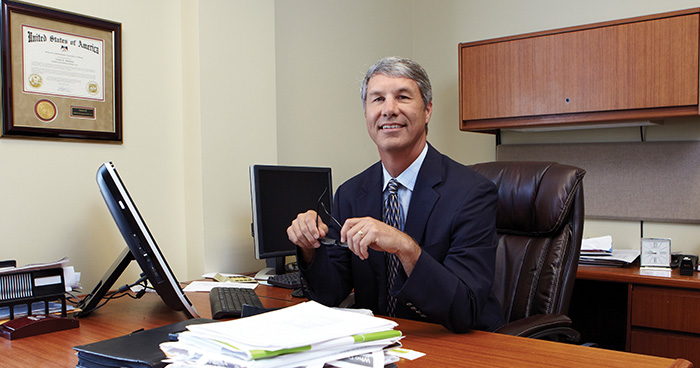Bull, bear, and everything in between: Coaching clients through the entire investment cycle
Bull, bear, and everything in between: Coaching clients through the entire investment cycle

Gary Strawn • Plano, Texas
Transamerica Financial Advisors
As football fans know, there are four quarters in a game. And although each quarter ends with a winner and a loser, all that matters is who’s on top when the fourth quarter ends. Gary Strawn, investment advisor and football fan, knows that coaching his clients through a full market cycle requires endurance, a long time horizon, and active risk management.
The dot-com bust really changed my mindset, and in the next few years we were introduced to active investment management. By about 2006, active money management was fairly well set in place as an approach we were comfortable with introducing to client portfolios. Our target market is middle-class American clients—and we think their need for financial planning and the close attention of advisors is still largely untapped.
As we spread the active management story, we like taking what high-net-worth clients have been doing in all phases of financial planning and investing, and bringing that to the middle class to give them the same opportunities. Providing clients with access to some of the most sophisticated investment strategies out there has had a tremendous impact on our business.

The goal is to help to educate clients and provide the full range of financial-services resources that they need. Risk management is a concept foreign to many walking in our door, and I enjoy the process of helping clients to understand those principles.
As this group ages, their biggest fear is another equity market drop of 30%, 40%, or even 50%. When someone is in the retirement mindset, the most frightening thing is losing assets that can provide an income stream throughout the rest of their lives. While I think annuities or insurance-based products might play a very appropriate role for many people, I also think they tend to be oversold on the fear factor. Plus, you can throw in the added fact that fixed-income instruments are not providing the historic returns that could help beat inflation.
If you combine all of these concerns with the realities of today’s investment environment, active management begins to make perfect sense as we explain it to clients. In today’s market, you really can’t have a 60/40 mix in a passive investment mode and provide enough income for their actuarially based longevity and income needs over time.
Clients need better growth with their assets than passive investing can provide, and with more control of risk. This is where active management comes in—providing an opportunity to grow assets through the markets, with a stronger level of potential protection in times of severe market downturns.
If your client’s portfolio is going to take on more risk conceptually on an asset-allocation basis, tools need to be in place to move a portfolio according to what current market conditions are dictating. No predictions, just unemotional, market-based strategies that use sophisticated analytical tools for decision-making.
 The natural inclination of most people—the human behavioral factor—is to want to chase returns or enter or exit the market at the wrong time. And that is exactly why the well-documented investment record of most people is so poor.
The natural inclination of most people—the human behavioral factor—is to want to chase returns or enter or exit the market at the wrong time. And that is exactly why the well-documented investment record of most people is so poor.
Clients really have to understand the full-cycle nature of investing in general, especially as it relates to actively managed investment approaches. Risk management means exactly that, and it can sometimes lead to underperformance in bull markets. Some active strategies might also not match market returns in difficult sideways markets. But those same strategies might do extremely well when considering both bull and bear markets in their totality.
Even within active management, it is tempting to try to chase returns and allocate more to strategies that have done well over the past year or so. That is where our discipline comes in. Our approach is to construct a diversified blend of active strategies with different potential performance characteristics that can work well together over various market cycles.
I tell clients it is very much like a football game—and you know we are real football fans here in Texas. You have to go through four quarters to find out who wins the game. Anybody—even the best teams—can be behind at halftime, or after the first or third quarter, but that’s not the point. The point is that the full investment cycle is a bull and a bear market and everything in between. Only after you get through those two cycles can you determine how effective you were in your investment process.
We are looking at a minimum of seven to nine years as a time horizon and, practically speaking, much longer than that. We can’t look at it on a quarter-by-quarter basis, or even year by year. Sometimes short-term comparisons are favorable versus the broad market for active strategies, and sometimes they are not. But it is who wins the game at the end that really counts. We have a lot of confidence in our ability to coach our clients through that entire process.
Disclosure: Gary Strawn is a registered representative and an investment advisor representative with Transamerica Financial Advisors, Inc. Securities and investment advisory services offered through Transamerica Financial Advisors, Inc. (TFA), Transamerica Financial Group Division—member FINRA, SIPC, and registered investment advisor. Non-securities products and services are not offered through TFA. Tax and/or legal advice not offered by Transamerica Financial Advisor, Inc., Transamerica Financial Group Division or their affiliated companies. Please consult with your personal tax professional or legal advisor for further guidance on tax or legal matters. TFG004852-09/14.
Photography by Nathan Whitney

